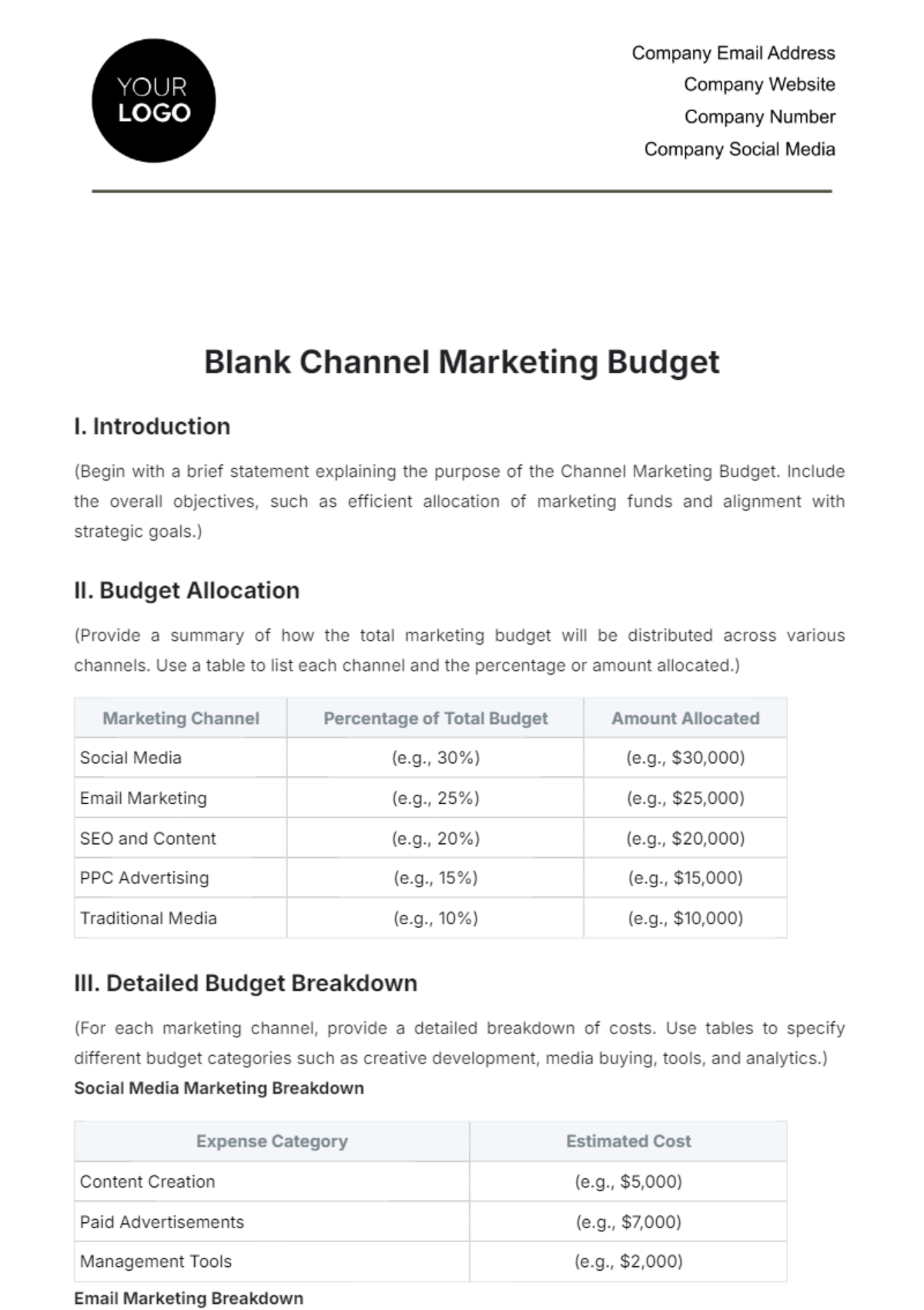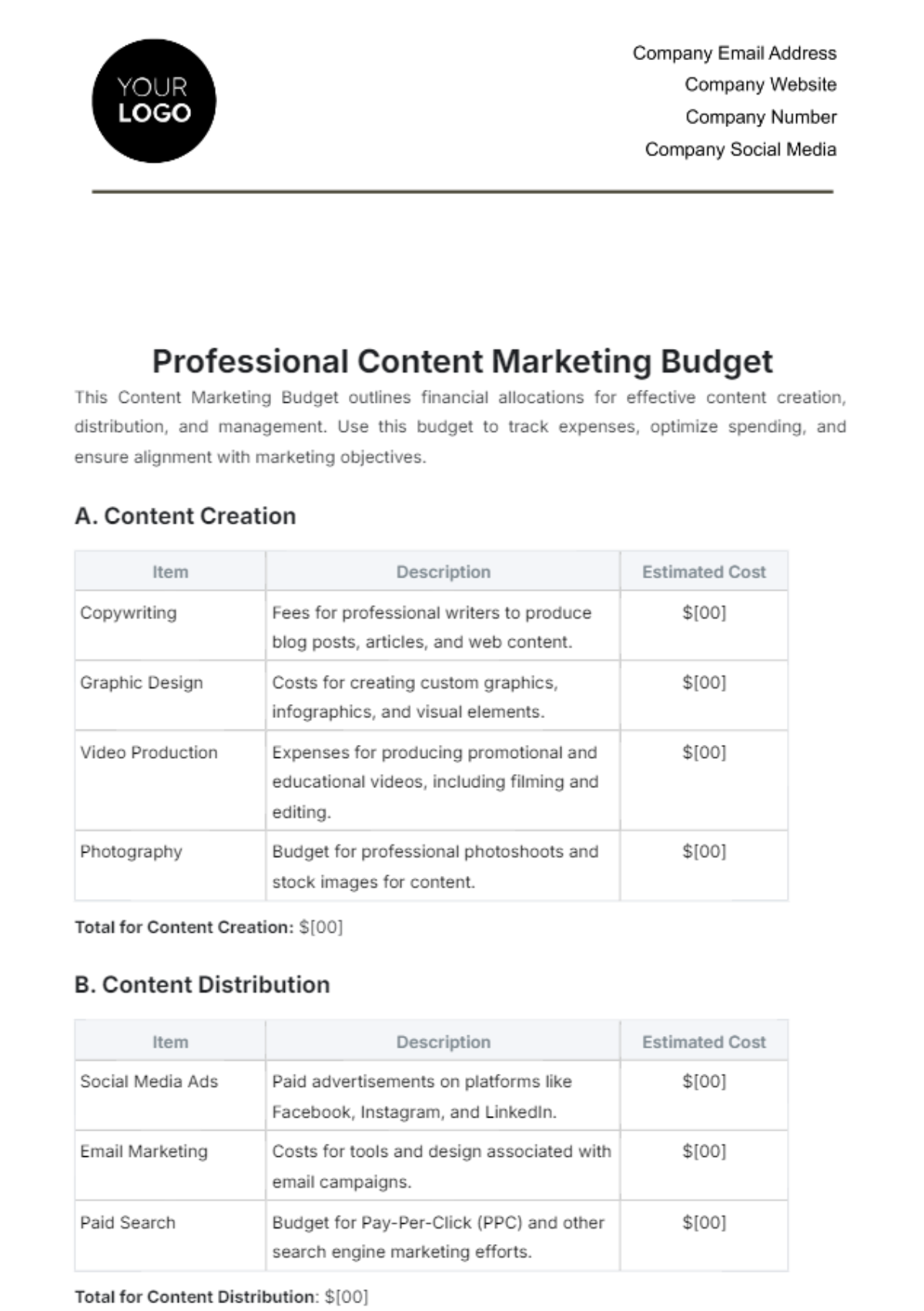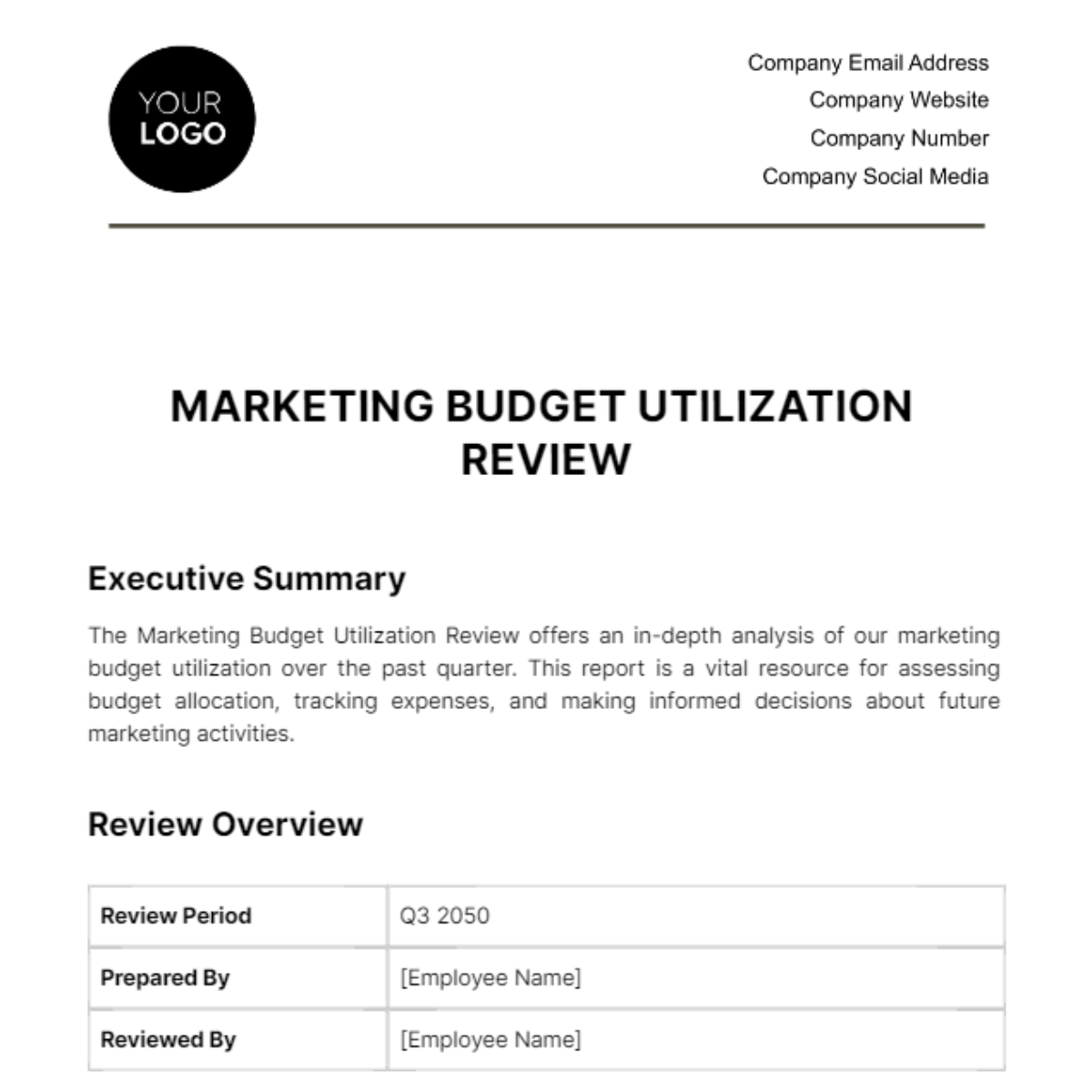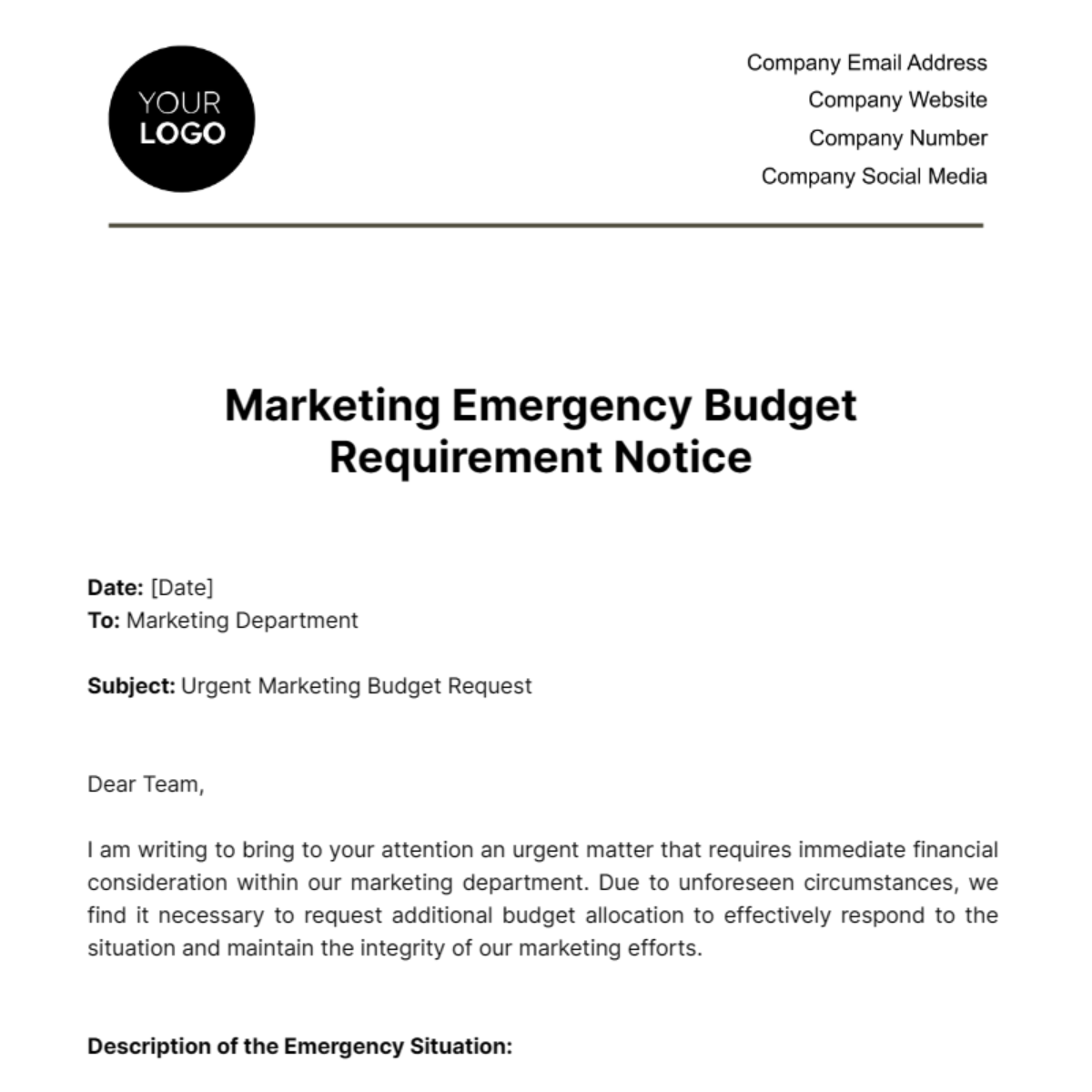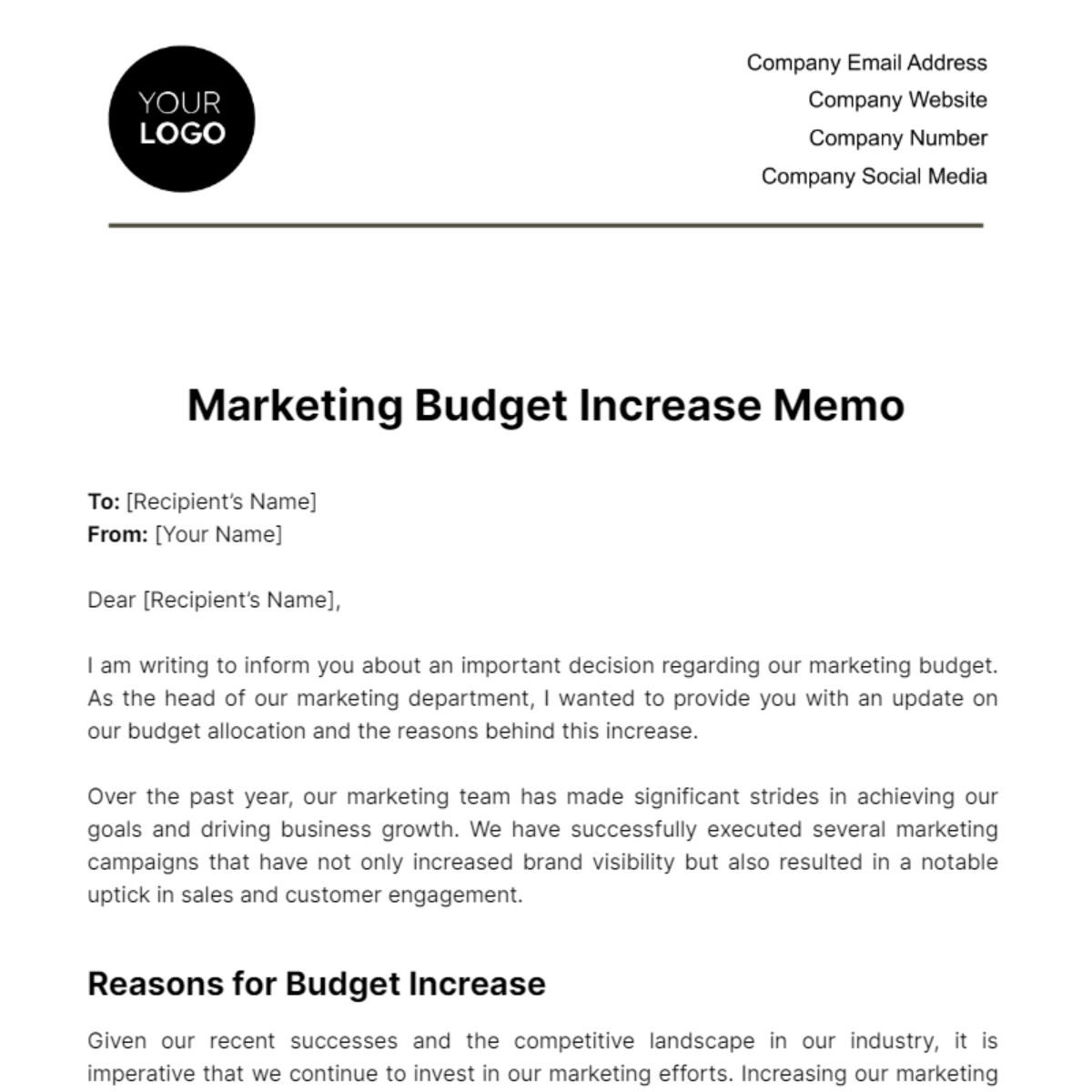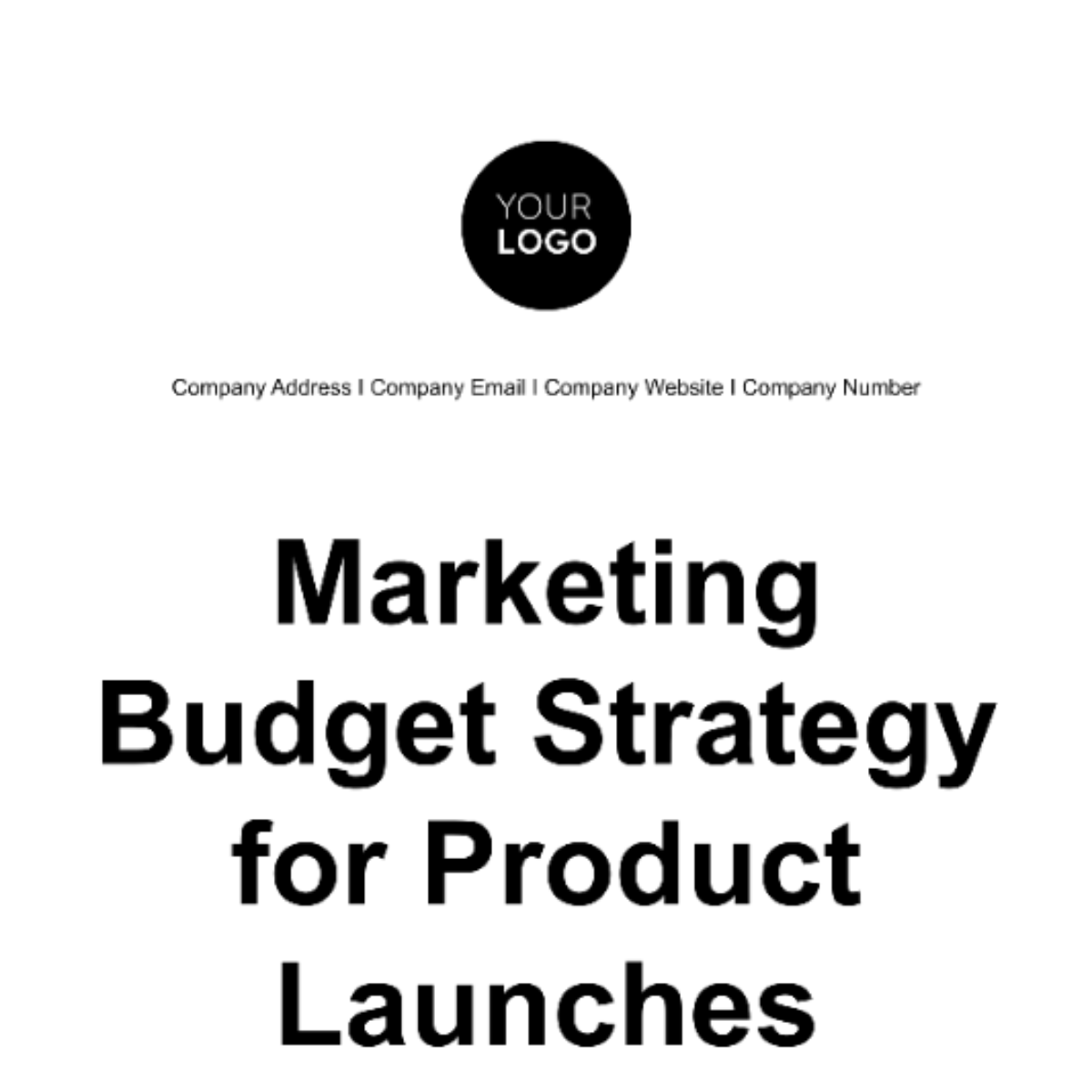Marketing Forecasting And Predictive Budget Planning
1. Executive Summary
This Marketing Forecasting and Predictive Budget Planning serves as a compass guiding [Your Company Name] towards successful marketing endeavors in the year 2050. This document is more than just a mere roadmap; it's a meticulously crafted strategy that encapsulates the essence of data-driven decision-making.
In a rapidly evolving business landscape, we recognize the paramount importance of comprehensive planning. Our approach begins with a deep dive into market trends, harnessing the power of predictive analysis to anticipate shifts and opportunities. Clear, measurable objectives have been set to align marketing efforts with overarching business goals, whether it's expanding brand reach, driving sales growth, or securing a larger market share.
Understanding the heart of any successful marketing campaign, the target audience, is imperative. We've delved into detailed audience profiles, ensuring that every strategy and tactic is finely tuned to resonate with their unique preferences and needs.
Budget allocation, a critical aspect of any marketing strategy, is carefully outlined. This budget allocation plan intelligently distributes resources across diverse marketing channels and initiatives to ensure maximum efficiency and return on investment.
The culmination of this document is the Marketing Forecast, offering a glimpse into the future of [Your Company Name]'s marketing efforts. This forecast, complete with projected metrics such as website traffic, conversion rates, and anticipated revenue, provides a tangible vision of expected outcomes.
In embracing the strategies and insights presented within this document, [Your Company Name] is well-positioned to navigate the dynamic marketing landscape of 2050, making data-driven decisions that maximize ROI and secure lasting success.
2. Introduction
In the digital age, effective marketing requires precise planning. This document outlines a comprehensive approach for [Your Company Name] to achieve its marketing goals while optimizing budgets for 2050.
3. Market Analysis
A comprehensive understanding of the market landscape in 2050 is crucial for guiding [Your Company Name]'s marketing strategy. This in-depth analysis encompasses various facets, including competitor assessments, consumer behavior trends, and the influence of emerging technologies.
3.1. Competitor Assessments
To thrive in a dynamic marketplace, it's essential to gauge the strategies and performance of key competitors. In 2050, our analysis reveals that [Competitor 1] has been excelling in digital advertising, particularly through innovative AI-driven campaigns. [Competitor 2], on the other hand, has gained a strong social media presence, engaging consumers effectively. By studying their strengths and weaknesses, [Your Company Name] can gain valuable insights into competitive strategies.
3.2. Consumer Behavior Trends
2050 witnesses a significant shift in consumer behavior. Data shows that consumers are increasingly favoring sustainable and eco-friendly products, aligning with global environmental concerns. Additionally, there's a growing preference for seamless online experiences, with a surge in mobile shopping. [Your Company Name] should consider these trends when crafting marketing strategies to meet evolving consumer demands.
3.3. Emerging Technologies
In the tech-driven landscape of 2050, staying abreast of emerging technologies is pivotal. Artificial Intelligence (AI) and Augmented Reality (AR) are becoming integral to marketing strategies. AI-powered chatbots enhance customer interactions, while AR applications offer immersive shopping experiences. [Your Company Name] should explore these technologies to stay competitive.
Aspect | Insights |
Competitor Assessments | Competitor 1 has excelled in digital advertising through AI-driven campaigns, achieving a 15% increase in online conversions compared to the previous year. Competitor 2 has established a strong social media presence, resulting in a 20% boost in engagement rates. |
Consumer Behavior Trends | Consumer preferences have shifted significantly. There is a growing demand for sustainable and eco-friendly products, with a 30% increase in sales of such items. Mobile shopping has seen a surge, with a 40% rise in purchases made via mobile devices. |
Emerging Technologies | The influence of Artificial Intelligence (AI) and Augmented Reality (AR) is notable. AI-powered chatbots have improved customer interactions, reducing response times by 50%. AR applications have revolutionized shopping experiences, resulting in a 25% increase in online conversions. |
This comprehensive table provides detailed insights into the Market Analysis for 2050. It encompasses competitor assessments, consumer behavior trends, and the impact of emerging technologies, allowing [Your Company Name] to make informed marketing decisions aligned with the market landscape.
4. Marketing Objectives
In the dynamic landscape of 2050, setting clear and measurable marketing objectives is paramount for [Your Company Name] to thrive and accomplish its overarching business goals. The following objectives have been meticulously outlined to drive strategic focus and ensure alignment with the company's mission:
Increasing Brand Awareness: The first and foremost objective is to enhance [Your Company Name]'s brand visibility and recognition in the market. By 2050, the aim is to achieve a 25% increase in brand awareness through targeted marketing campaigns and widespread digital presence.
Boosting Sales: Driving revenue growth is a central goal. By 2050, the objective is to achieve a 30% increase in sales, leveraging data-driven strategies to convert leads into loyal customers and harnessing emerging technologies for seamless shopping experiences.
Expanding Market Share: To solidify its position in the market, [Your Company Name] aims to expand its market share by 20% in 2050. This will be achieved through strategic market penetration and competitive pricing strategies.
Customer Engagement: Engaging customers on a deeper level is pivotal. The objective is to increase customer engagement by 15%, fostering brand loyalty through personalized interactions and exceptional customer experiences.
Sustainable Growth: In alignment with evolving consumer preferences, [Your Company Name] seeks to become a leader in sustainable practices. The objective is to incorporate sustainability into all aspects of the business and achieve a 50% reduction in the carbon footprint by 2050.
Online Dominance: As online shopping continues to surge, [Your Company Name] aims to dominate the digital space. The objective is to achieve a 40% increase in online sales and establish [Your Company Name] as an e-commerce leader by 2050.
To provide a snapshot of these marketing objectives, here's the data:
These marketing objectives for 2050 serve as guiding principles, ensuring that [Your Company Name] is poised to meet the evolving needs and expectations of its target audience while driving sustainable growth and market dominance.
5. Target Audience
In the ever-evolving landscape of marketing in 2050, understanding the intricacies of the target audience is paramount. Detailed profiles of the target audience segments have been meticulously crafted to provide [Your Company Name] with a deep and nuanced understanding of their needs, preferences, and behaviors. This understanding serves as the bedrock upon which effective and resonant marketing strategies are built.
Target Audience Segments
Segment | Demographics | Characteristics | Needs and Preferences |
Millennial Innovators | Primarily aged 25 to 40 in various professions, from tech enthusiasts to creative entrepreneurs. | Early adopters of technology value sustainability, socially conscious, seek innovation and authenticity. | Prefer brands prioritizing sustainability, offering innovative products, engaging through immersive digital experiences, value authenticity and ethical business practices. |
Baby Boomer Explorers | Aged 55 to 75, active retirees with disposable income. | Adventurous, value experiences over possessions, strong brand loyalty. | Seek unique travel experiences, quality products, personalized services, responsive to nostalgia-inducing marketing campaigns. |
Gen Z Digital Natives | Aged 18 to 24, grown up in a digitally connected world. | Tech-savvy, socially conscious, value diversity and inclusivity. | Expect seamless online experiences, personalized content, favor brands championing social causes, engage with brands reflecting their values. |
Corporate Decision Makers | Aged 35 to 60, leadership roles within corporations. | Prioritize efficiency, data-driven decision-making, value-added solutions. | Seek business partners providing data-driven insights, innovative solutions, reliability track record, professionalism, clear communication. |
This structured table provides a clear overview of the demographics, characteristics, and preferences of each target audience segment. It serves as a valuable reference for [Your Company Name] to craft tailored marketing strategies for each group in the year 2050.
6. Marketing Strategies
In the dynamic and data-driven landscape of 2050, the success of [Your Company Name]'s marketing efforts hinges on a diversified array of strategies designed to resonate with the target audience while achieving precise objectives. Each strategy has been meticulously crafted to align with the unique characteristics and preferences of the identified target audience segments, ensuring maximum impact and effectiveness.
6.1. Content Marketing
Content reigns supreme in the digital age. [Company Name]'s content marketing strategy focuses on producing high-quality, informative, and engaging content that addresses the specific needs and interests of each target audience segment. For the Millennial Innovators, this means content highlighting sustainability and innovation. For Baby Boomer Explorers, it involves sharing captivating travel stories and nostalgic content. Gen Z Digital Natives receive personalized, socially conscious content, while Corporate Decision Makers access data-driven insights and thought leadership articles.
6.2. Social Media Campaigns
Social media remains a cornerstone of modern marketing. [Your Company Name] leverages the power of platforms like Facebook, Instagram, and LinkedIn to connect with each target audience segment. Creative and visually appealing content is tailored to each group's preferences. Millennial Innovators receive content emphasizing sustainability and innovation, while Baby Boomer Explorers enjoy content showcasing unique travel experiences. Gen Z Digital Natives engage with socially conscious and interactive content, while Corporate Decision Makers access industry-specific insights and networking opportunities.
6.3. Email Marketing
Email marketing is a direct channel to engage and nurture leads. Personalized email campaigns are deployed to each target audience segment. For instance, Millennial Innovators receive emails highlighting sustainability initiatives and product innovations, while Baby Boomer Explorers receive exclusive travel offers and nostalgia-inducing content. Gen Z Digital Natives are sent socially responsible and interactive emails, while Corporate Decision Makers receive thought leadership and industry updates.
6.4. Influencer Partnerships
Influencer marketing continues to be a powerful tool. [Your Company Name] collaborates with influencers whose values align with each target audience segment. Millennial Innovators are introduced to influencers advocating sustainability, while Baby Boomer Explorers are connected with travel influencers. Gen Z Digital Natives engage with influencers championing social causes, and Corporate Decision Makers benefit from thought leaders within their industry.
6.5. Paid Advertising
Paid advertising ensures visibility in a crowded digital landscape. [Your Company Name] utilizes paid channels, such as PPC and display ads, to reach specific segments with precision. Ads are designed to resonate with the unique preferences of each audience, whether it's promoting sustainability for Millennial Innovators, travel offers for Baby Boomer Explorers, socially conscious initiatives for Gen Z Digital Natives, or data-driven solutions for Corporate Decision Makers.
These tailored marketing strategies represent the heart of [Your Company Name]'s efforts in 2050, ensuring that every interaction with the target audience is purposeful and resonant. By aligning strategies with audience characteristics and preferences, [Your Company Name] is poised for success in a highly competitive and dynamic market.
7. Budget Allocation
Effective marketing in 2050 requires not only precise strategies but also a strategic distribution of resources. In this chapter, we unveil a meticulously crafted budget allocation plan that serves as the financial blueprint for [Your Company Name]'s marketing endeavors. This plan outlines how resources will be distributed across various marketing channels and initiatives, with a singular aim - to maximize efficiency and return on investment (ROI).
Budget Allocation Plan - 2050
Marketing Channel/Initiative | Budget Allocation ($) |
Content Marketing | $120,000 |
Social Media Campaigns | $90,000 |
Email Marketing | $50,000 |
Influencer Partnerships | $75,000 |
Paid Advertising | $140,000 |
SEO and Website Maintenance | $60,000 |
Research and Analytics | $45,000 |
Miscellaneous and Contingency | $30,000 |
Total Marketing Budget | $610,000 |
8. Marketing Forecast
In the ever-evolving landscape of marketing, having a clear vision of future outcomes is imperative for [Your Company Name]'s success in 2050. This chapter unveils a comprehensive marketing forecast that serves as a navigational guide for the year ahead. The forecast encompasses a range of projected metrics, from website traffic to conversion rates and revenue, providing [Your Company Name] with a well-defined picture of what to anticipate.
Projected Metrics - 2050
Metric | Projections for 2050 |
Website Traffic | 2,500,000 monthly visits |
Conversion Rates | 12% |
Revenue | $25,000,000 |
Website Traffic: By leveraging strategic content marketing and SEO efforts, [Your Company Name] anticipates a significant increase in website traffic. The projection of 2,500,000 monthly visits reflects the brand's ability to attract and engage a substantial online audience.
Conversion Rates: With personalized and resonant marketing strategies, [Your Company Name] expects an impressive conversion rate of 12%. This means that a substantial portion of the website visitors is likely to convert into loyal customers or clients.
Revenue: The culmination of these efforts is reflected in the projected revenue of $25,000,000 for the year 2050. This figure signifies [Your Company Name]'s commitment to not only attracting customers but also ensuring they make meaningful purchases, ultimately driving the company's growth and success.
This marketing forecast equips [Your Company Name] with valuable insights into the expected outcomes of its marketing efforts in 2050. It not only serves as a benchmark for success but also allows for proactive adjustments in strategies should any deviations occur. With this clear picture of expected outcomes, [Your Company Name] is well-prepared to navigate the dynamic marketing landscape of 2050 with confidence and data-driven decision-making.
9. Conclusion
This Marketing Forecasting and Predictive Budget Planning document equips [Your Company Name] with a strategic blueprint to navigate the dynamic marketing landscape of 2050. By aligning objectives, strategies, and budgets, [Your Company Name] is poised for success.
10. Appendices
Relevant data, charts, and supplementary information, including detailed budget breakdowns and market research findings, are attached for reference.



